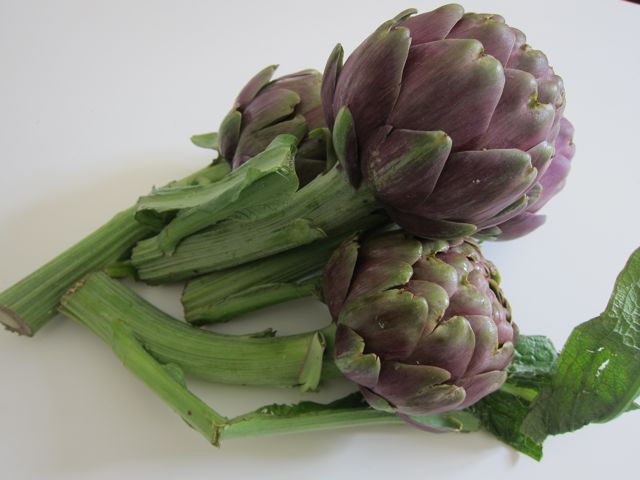
I’ve been an artichokaholic since I was a child. One of the biggest treats I can remember, growing up in the suburbs of St. Louis, was my mother coming back from Bettendorf’s with a bag of big, round artichokes. She would rinse them, boil them for an hour or so, and then we’d each get one, with a small bowl of melted butter and lemon juice on the side. My sisters and I would gently tear off the leaves, dipping them in to the butter, before scraping off the flesh with our teeth. Finally, we’d get to the heart, which I would proceed to chop into little pieces and dump unceremoniously into the lemony butter, scooping it all up together with a spoon. It was as much about the fussy process and butter as it was about any sort of artichoke taste. I mean, these artichokes came from California, I guess, so any sort of ‘freshness’ was probably long gone.
When I was 12 my family moved to Rome. We lived just down the street from Campo de’ Fiori, so this is where we shopped. While the intense colors, shapes and flavors have obviously had a huge influence on the rest of my life, what I remember most though, was the smell. There was a green, fresh, slightly bitter smell that I found irresistible.
I didn’t think much about that smell at the time. I was 12 years old, for goodness sakes. I think I just assumed it was the market in general. But years later, when I moved back to Rome I had my Proustian moment. I walked into the Campo early one morning, pushing a baby carriage, and the smell hit me again, all at once. I closed my eyes, and I was 12 years old, discovering Rome for the first time. When I opened my eyes, I realized that I was standing by an enormous mound of carciofi. And that green, bitter smell? That was the artichokes I was smelling. Their smell is so strong, and so fresh, that it overwhelms everything else. I never knew.
Which is all to say, a fresh Roman artichoke is a wonderful thing. The first ones to hit the stands – the cimaroli – are big and fat. They are the ones that grow from the main stalk of the artichoke plant, in early spring, pointing straight up. Not only are they incredibly fragrant and large, they are also amazingly tender, and have practically no choke or tough inner leaves.
In Italy no one would think of boiling or steaming a whole artichoke and doing the teeth scraping thing. Why? Because most of the artichokes are so tender, that a good portion of the leaf can actually be eaten. But to prepare them does take a bit of work, and can be quite fiddly.
The other day at the Roma Farmers Market I grabbed my first artichokes of the season. They were big fat cimaroli, and on the expensive side. In my book, there is only one way to cook these up: alla romana. Cleaned, trimmed, seasoned liberally with mint and parsley, and then steamed. Later on in the season the prices will get lower and I’ll be making things like risotto, pasta and vignarola. But for now, alla romana it is.
Rather than write up a recipe at the bottom of the post, like I usually do, I thought it would be more helpful to do a photo essay thing. Cleaning artichokes is hard to explain, so I hope this helps.
For those of you in Italy, you’ll know what kind of artichokes I’m talking about. For those of you in the States, things are a bit trickier. I think, for the most part, the Globe Artichokes you get in the supermarket are probably too tough for this recipe. If you are near a farmers market and can buy early, fresh artichokes, you’re in luck. I just listened to a great report on Evan Kleiman’s Good Food, which explains a bit about the kind of artichokes to look for (it’s in the market report, at the beginning of the show).
Before you begin, fill a big bowl with cold water. Squeeze a half lemon in, and keep the other half handy. Artichokes oxidize quickly, so you have to rub all cut surfaces with a lemon to prevent this. Once you are finished, you will place the cleaned artichoke in the water until you are ready to season them. You’ll also notice that your fingers will probably turn brown too. Either wear thin gloves (which I hate) or else keep rinsing and rubbing lemon on your hands, especially the finger tips.
Break off the tough, outer leaves of the artichoke, until you get down to the leaves which are tender. You’ll know you’re getting to the tender part by the color. They are usually yellow on the bottom third, and pale violet at the top. When you break off the leaves, do your best to leave on as much of the root of the leaf as possible.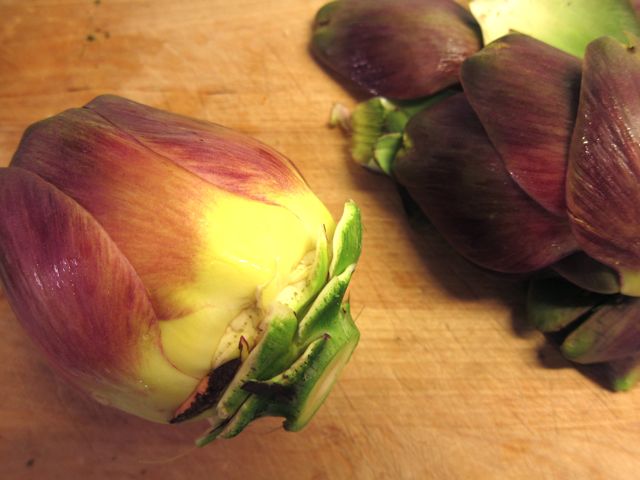
Once you have taken off the tough outer leaves, use a small knife and gently trim away the bright green parts from the stem end. Don’t cut off too much, just the green part. This part is quite bitter. Immediately rub with lemon.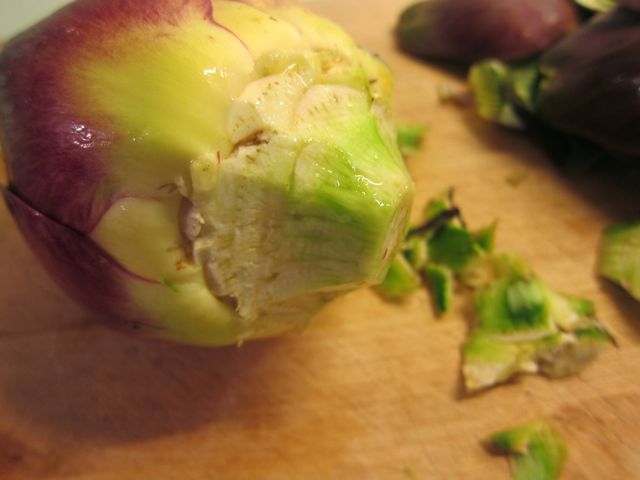
Turn the artichoke on its side, and cut off the top third (the pointy end of the artichoke). Make sure your knife is really sharp. Immediately rub the cut part with lemon, and put in acidulated water. 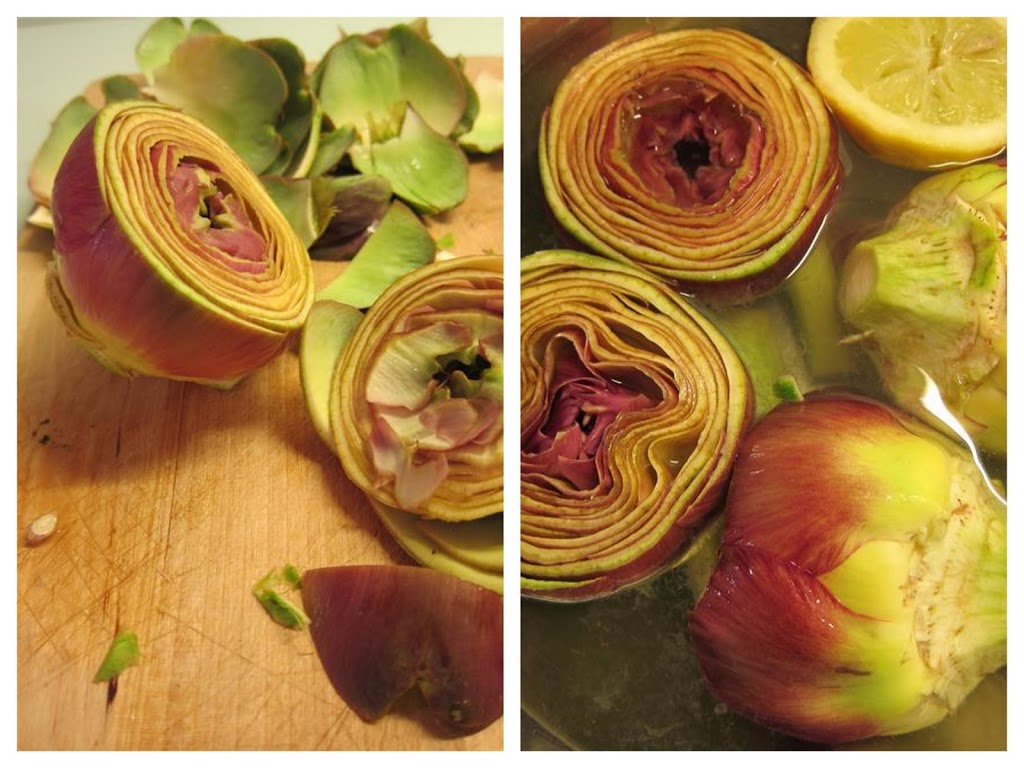
Take a bunch of parsley and a bunch of mint (the above amounts were good for 4 artichokes.) and 3 cloves of garlic. Chop finely, either with a mezzluna or in a food processor. As you chop, add 1/2 tsp of salt and about a 1/4 tsp of freshly ground pepper. Once chopped, place in small bowl and slowly add about a 1/4 cup of olive oil, stirring to amalgamate it. 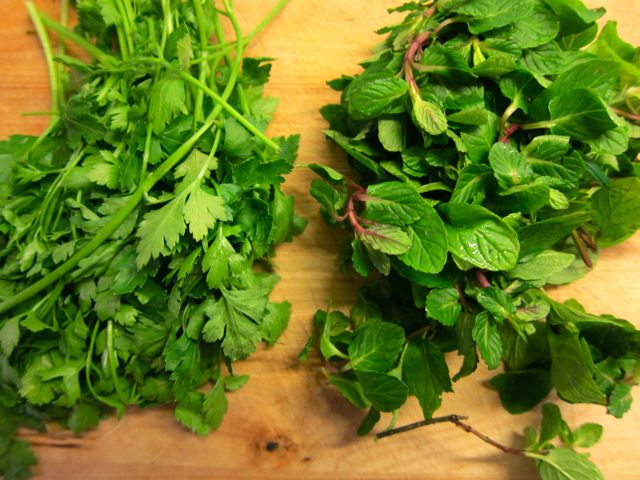
Lift an artichoke out of the water, and gently blot off water with paper towel. Hold the artichoke with one hand, and carefully loosen the leaves, being careful not to break any off. Take a bit the herb mixture and force it in between the leaves, and into the center of the artichoke. Keep doing this, until the artichoke is well seasoned. You want to use about 2 tablespoons of mixture per artichoke. Repeat for all the artichokes. 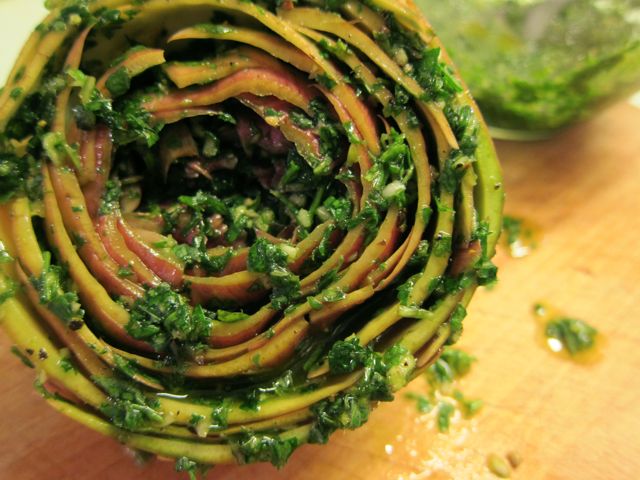
Choose a pot where the artichokes will fit very snugly, and place them, one against the other, with the tops up. If the stalks of the artichokes are big and thick, you can use those (trimmed of the tough outer part) to keep the artichokes from tipping over. Otherwise, you can use pieces of potato. Pour in enough water to come up about an inch, but be carful not to pour the water directly onto the artichokes. (you don’t want to dilute the seasoning). Sprinkle with salt and pepper, and drizzle abundantly with olive oil. Place the lid on the pot and bring to a low simmer. Cook until done, probably about 45 minutes to an hour. Keep checking, to make sure water hasn’t boiled away.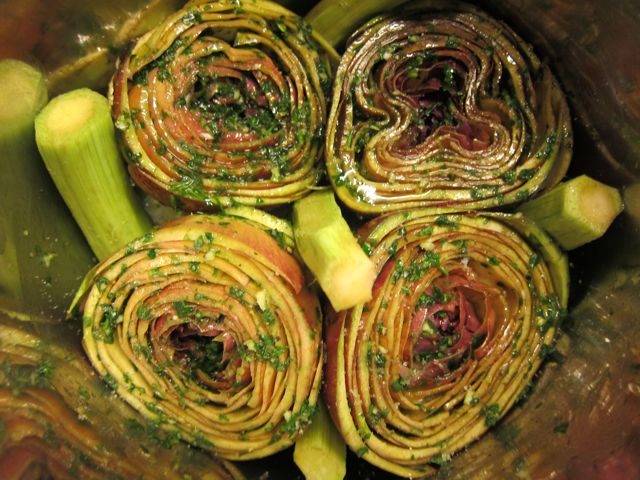
Carciofi alla Romana are best served room temperature. I like to place them in a deep serving dish, with the cooking liquid at the bottom and lots of fresh bread to soak it up.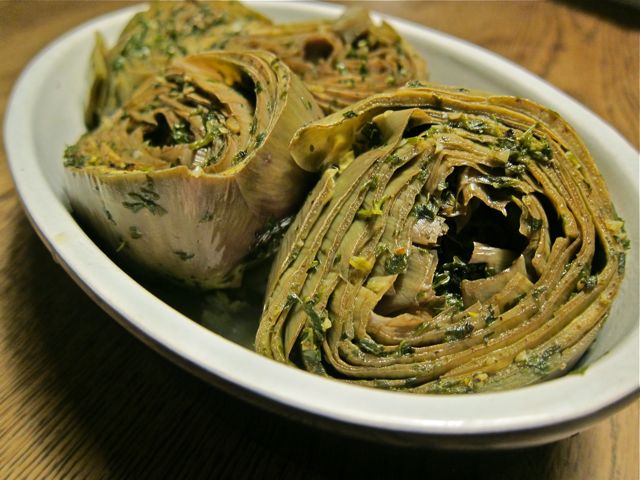
I love these pictures and find your instructions precise and easy to follow! I write a weekly post called tuscan cart about a single seasonal ingredient and also had artichokes this week!
Ciao,
Oriana
I think we can get these huge, beautiful carciofi at Whole Foods. They look so yummy!
Boy that looks good..much better than the Bettendorf variety!!! I will have to try this instead of the old way of dipping in melted butter, or sometimes salad dressing
Food of the gods!
Visiting Rome in 5 weeks…will they still be in season? what about asparagus?
Mmmmmm. They look so yummy. I guess when I visit in the fall they will be out of season. Might be reason enough to change my plans. . .
bella, just like my grandmother used to make….she didn’t use mint though, just parsely and lightly sprinkled some toasted breadcrumbs into the top with a good dose of olive oil…so good
Wow, so happy to see this. My very first time in a restaurant was in a Cork n’ Kleaver in Michigan in the 70s. It was a chain restaurant and yet they served fresh bread and we ordered the same artichokes that you had in St. Louis. I always remember that. Now that I live in Provence, I look at them in the market when they arrive with trepidation–no more! Thank you!
Anonymous: Yes, Asparagus should still be her in 5 weeks. The ones showing up now are imported, local ones haven’t even started yet. Can’t wait!
Will be renting an apartment in San Lorenzo…is there an outdoor market near there so I can shop daily for fresh ingredients?
That’s just the way we make them here-with fresh mint and Fulvio adds a pinch of anchovy paste .
I received your blog update today.I was so motivated by your carciofi images/recipe I dropped everything literally ran out to buy the ingredients including Hoboken NJ crusty bread- I add bread crumbs and more garlic- anyway thank you – I adore your blog!! I am in NJ beautiful waterfront but missing Rome very much… the day is stunning and I am looking at 20 swans gliding on the river….and dinner tonight will be glorious!
Anonymous: Here is a great list of all the markets in Rome. http://www.aglioolioepeperoncino.com/2011/01/local-rome-markets.html
Marcella: So glad you were inspired!
Mary Jane: anchovy paste is a great addition.
At Thoirs precise momento i am dining alome in a nothing-special Italian restaurant in Madrid. I ordered carciofi alla romana – I had no idea what to expect and am enjoying them so much I have googled them for a recipe and landed on your page. Thank you! I too remember eating artichokes the way you did as a child. I loved artichoke evenings – but nothing like this!
You mentioned nothing about scooping out the fuzzy stuff in the middle of the artichoke. I was always told as a child never to eat this and when we were ready to eat the heart we very carefully scrapped the heart clean. So we can eat the stuff in the middle?
Actually, I do talk about the choke, in the fourth paragraph. To say that they Roman Artichokes are a different kind, and in the spring, when the first ones come up, they have practically no choke. The ones you get in the states do have quite a big choke, and so you shouldn’t eat that part.
Elizabeth, thank you for this wonderfully precise description for preparing artichokes! Do you by any chance have any suggestions for picking out good artichokes?
The artichokes should look fresh, the leaves should not be dried out or split. The head of the artichoke should be covered tightly with leaves which should almost crack off when bent back. The most important thing about picking them is to look for freshness, as is true with everything!
I tried winging it when I got home to California. I wanted it to work so bad because I fell in love with this dish in Italy.
The artichokes I bought were rough. I’m going to give it another try.
I’m thinking of doing this in my Instant Pot. There’s a wire shelf to sit them on.
We’ll see…
The trick is trimming them correctly. I have a feeling you will have to trim off much more than you think. While the instant pot is a great idea, even that won’t work on the tough outter leaves that need to be trimmed away.
I want to have 8 precocce before I cook them.How long will they stay in the refrigerator or can they be frozen? Grazie
Artichokes can stay in the fridge for about 5 days. After that they lose a lot of their taste.
I made vignarola last week. It’s a stew of artichokes, broad beans, onions and peas. Delicious. Obviously, I had to use frozen broad beans and peas, but that didn’t detract at all.
I love vignarola
I did it with the American globe artichokes! Not as good as yours for sure but much better than any I’ve had here before. Thank you!
Fantastic!